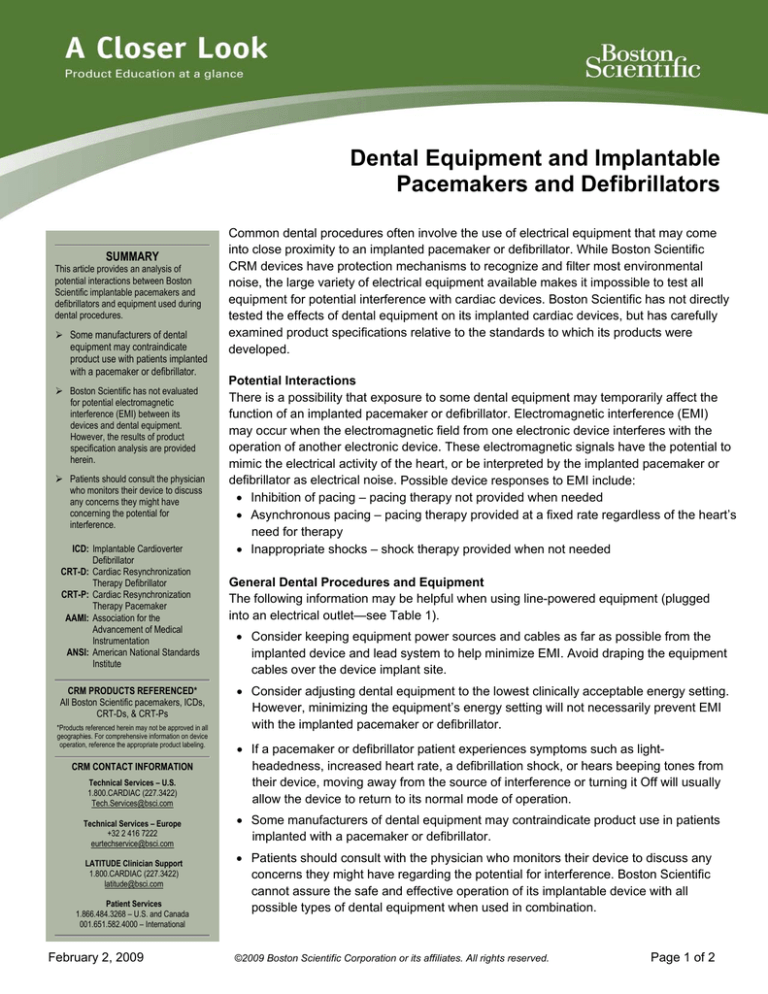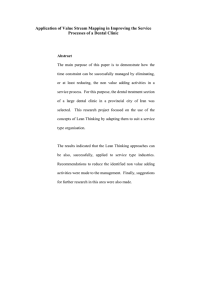
Dental Equipment and Implantable
Pacemakers and Defibrillators
SUMMARY
This article provides an analysis of
potential interactions between Boston
Scientific implantable pacemakers and
defibrillators and equipment used during
dental procedures.
¾ Some manufacturers of dental
equipment may contraindicate
product use with patients implanted
with a pacemaker or defibrillator.
¾ Boston Scientific has not evaluated
for potential electromagnetic
interference (EMI) between its
devices and dental equipment.
However, the results of product
specification analysis are provided
herein.
¾ Patients should consult the physician
who monitors their device to discuss
any concerns they might have
concerning the potential for
interference.
ICD: Implantable Cardioverter
Defibrillator
CRT-D: Cardiac Resynchronization
Therapy Defibrillator
CRT-P: Cardiac Resynchronization
Therapy Pacemaker
AAMI: Association for the
Advancement of Medical
Instrumentation
ANSI: American National Standards
Institute
CRM PRODUCTS REFERENCED*
All Boston Scientific pacemakers, ICDs,
CRT-Ds, & CRT-Ps
*Products referenced herein may not be approved in all
geographies. For comprehensive information on device
operation, reference the appropriate product labeling.
CRM CONTACT INFORMATION
Technical Services – U.S.
1.800.CARDIAC (227.3422)
Tech.Services@bsci.com
Technical Services – Europe
+32 2 416 7222
eurtechservice@bsci.com
LATITUDE Clinician Support
1.800.CARDIAC (227.3422)
latitude@bsci.com
Patient Services
1.866.484.3268 – U.S. and Canada
001.651.582.4000 – International
February 2, 2009
Common dental procedures often involve the use of electrical equipment that may come
into close proximity to an implanted pacemaker or defibrillator. While Boston Scientific
CRM devices have protection mechanisms to recognize and filter most environmental
noise, the large variety of electrical equipment available makes it impossible to test all
equipment for potential interference with cardiac devices. Boston Scientific has not directly
tested the effects of dental equipment on its implanted cardiac devices, but has carefully
examined product specifications relative to the standards to which its products were
developed.
Potential Interactions
There is a possibility that exposure to some dental equipment may temporarily affect the
function of an implanted pacemaker or defibrillator. Electromagnetic interference (EMI)
may occur when the electromagnetic field from one electronic device interferes with the
operation of another electronic device. These electromagnetic signals have the potential to
mimic the electrical activity of the heart, or be interpreted by the implanted pacemaker or
defibrillator as electrical noise. Possible device responses to EMI include:
• Inhibition of pacing – pacing therapy not provided when needed
• Asynchronous pacing – pacing therapy provided at a fixed rate regardless of the heart’s
need for therapy
• Inappropriate shocks – shock therapy provided when not needed
General Dental Procedures and Equipment
The following information may be helpful when using line-powered equipment (plugged
into an electrical outlet—see Table 1).
• Consider keeping equipment power sources and cables as far as possible from the
implanted device and lead system to help minimize EMI. Avoid draping the equipment
cables over the device implant site.
• Consider adjusting dental equipment to the lowest clinically acceptable energy setting.
However, minimizing the equipment’s energy setting will not necessarily prevent EMI
with the implanted pacemaker or defibrillator.
• If a pacemaker or defibrillator patient experiences symptoms such as lightheadedness, increased heart rate, a defibrillation shock, or hears beeping tones from
their device, moving away from the source of interference or turning it Off will usually
allow the device to return to its normal mode of operation.
• Some manufacturers of dental equipment may contraindicate product use in patients
implanted with a pacemaker or defibrillator.
• Patients should consult with the physician who monitors their device to discuss any
concerns they might have regarding the potential for interference. Boston Scientific
cannot assure the safe and effective operation of its implantable device with all
possible types of dental equipment when used in combination.
©2009 Boston Scientific Corporation or its affiliates. All rights reserved.
Page 1 of 2
If more information can be provided to CRM Technical Services specific to dental equipment used (brand, model, operating
frequency and amplitude), our engineering staff may be able to provide additional insight into the potential for interference.
Table 1. Boston Scientific Analysis1 of Dental Equipment and Potential Interactions with Implantable Pacemakers and Defibrillators
Dental Equipment
Drills and cleaning
equipment
Dental X-rays
Ultrasonic dental
scalers
Apex locators
Dental chairs with
magnetic headrests
Electrocautery
Equipment Function & Potential Interactions
Most dental drills and cleaning equipment should not affect cardiac device function.
Most diagnostic tools using ionizing radiation, such as radiography (X-ray), have not been identified as sources of device
interference or damage. Dental X-rays should not affect pacemaker or defibrillator function.
Ultrasonic dental scalers use fast vibrations to clean teeth through one of two energy conversion technologies:2
• Magnetorestrictive—uses a pulsing magnetic field applied to a metal “stack” that flexes to move tip in an elliptical
pattern.
• Piezoelectric—uses pulsing voltage applied to ceramic crystals to move the tip in a reciprocating pattern.
Boston Scientific devices comply with the AAMI PC69 standard,3 which in general suggests Boston Scientific devices
should not be affected by interference from peak magnetic field intensities less than 20 A/m (0.25 Gauss) between 10 to
100 kHz. A recent independent study conducted to investigate the potential for EMI between dental equipment and
defibrillators identified no interference from the piezoelectric dental scaler tested.4
Though Boston Scientific analysis indicates that device interference due to ultrasonic dental scaler use is unlikely, testing
for potential EMI between our devices and ultrasonic dental scalers has not been conducted, and we cannot guarantee
compatibility between the two technologies. While Boston Scientific has not identified any ultrasonic dental scalers that
interfere with our implanted devices, caution should be exercised.
Apex locators are used by dentists to determine the length of the root canal space.
Recent independent studies conducted to investigate the potential for EMI between dental equipment and pacemakers
and/or defibrillators identified no interference from the apex locators tested.5,6
Though Boston Scientific analysis indicates that device interference due to apex locator use is unlikely, Boston Scientific
has not conducted testing for potential EMI between its devices and apex locators, and cannot guarantee compatibility
between the two technologies. While Boston Scientific has not identified any apex locators that interfere with our
implanted devices, caution should be exercised.
Some dental chairs contain magnets located in the headrest. If the pacemaker or defibrillator is programmed not to
respond to a magnet, patients may sit in these chairs. If the implanted device is programmed to respond to a magnet and:
• The magnet power is less than 10 Gauss (1mTesla)—patients may sit in these chairs.
• The magnet power is greater than or equal to 10 Gauss (1mTesla)—patients should not sit in these chairs as
device function/programming may be affected.
Electrocautery may temporarily affect the function of an implanted pacemaker or defibrillator.
During electrocautery use, Boston Scientific defibrillators can be temporarily deactivated and a pacemaker can be
programmed to pace asynchronously. The physician who monitors the patient’s implantable device should be contacted
to discuss the use of electrocautery and the potential impact of these programming options. Reference device
Instructions for Use manuals or the A Closer Look article, Electrocautery and Implantable Device Systems for further
instructions / precautions when using electrocautery during dental procedures. This information is available through
CRM Technical Services or on Boston Scientific’s website.7
1
Boston Scientific has not directly tested the effects of dental equipment on its implanted cardiac devices, but has carefully examined product specifications relative to the
standards to which its products were developed.
2
The Free Dictionary by Farlex web page. Available at http://medical-dictionary.thefreedictionary.com/ultrasonic,+magnetostrictive+scaler. Accessed on October 24, 2008.
3
ANSI/AAMI PC69:2007. Active implantable medical devices—Electromagnetic compatibility—EMC test protocols for implantable cardiac pacemakers and implantable
cardioverter defibrillators, pp 76-80.
4
Brand, HS, Entjes, ML, Nieuw Amerongen, AV, van der Hoeff, EV, Schrama, TAM. Interference of electrical dental equipment with Implantable Cardioverter-defibrillators.
British Dental Journal. 2007; 203:577-579.
5
Garofalo, RR, Ede, EE, Dorn, SO, Kuttler, S. Effect of Electronic Apex Locators on Cardiac Pacemaker Function. Journal of Endodontics. 2002; 28:831-833.
6
Wilson, BL, Broberk, C, Baumgartner, JC, Harris, C, Kron, J. Safety of Electronic Apex Locators and Pulp Testers in Patients with Implanted Cardiac Pacemakers or
Cardioverter/Defibrillators. Journal of Endodontics. 2006; 32: 847-582.
7
A Closer Look article, Electrocautery and Implantable Device Systems website path: bostonscientific.com > Product Performance Resource Center > A Closer Look
Articles > EMI (left side bar). Instructions for Use manuals website path: bostonscientific.com > Cardiac Rhythm Management > Physician Instructions for Use.
February 2, 2009
©2009 Boston Scientific Corporation or its affiliates. All rights reserved.
Page 2 of 2




